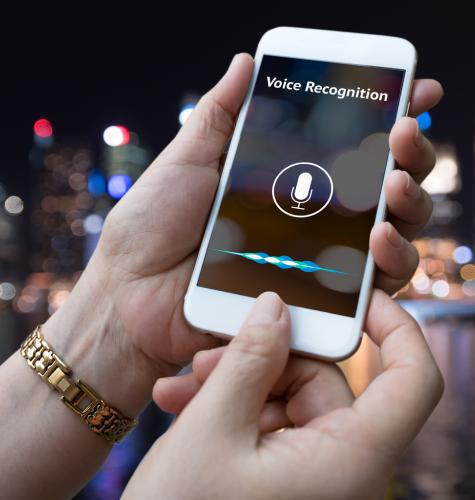“Digital Beyond the Transformation” is about bringing digital to the core of processes, people, and products, so that enterprises evolve into change agents, fully equipped to keep pace with emerging technologies and the disruptions that may ensue.
5 trends driving digital transformation
Develop capabilities to stay ahead of the digital curve
Photon has formed a unique perspective on key digital trends through working with visionary leaders across industries, including retail, healthcare, CPG, pharma, and FinServ. Our goal is helping digitally transformative companies stay relevant in this intensely competitive space. This article sheds light on specific capabilities and best practices that help make Digital—Beyond the Transformation—a reality.
Connect with Photon to learn the necessary steps to becoming a digitally transformed enterprise.
In the early years of digital transformation, value shifted significantly from the infrastructure to the application layer with the rise of mobile, front-end experiences becoming all the rage, and the back-end moving to the API economy. The infrastructure layers were considered a “commodity” after the wave of commoditization of hardware and the lower levels of software that ran on it.
However, a dramatic shift happened with the rise of two entirely new waves of infrastructure modernization:
- the public cloud and complete reimagining of core back-end middleware
- the surge of shared memory and isolated application infrastructure with containers
Couple these with the third wave of DevOps, and now you have infrastructure that is CODE.
This shift has required digital enterprises to master new skills pertaining to cloud engineering. This also led to an unprecedented increase in the pace of digital disruption, subsequently driving enterprises in various industries to embrace digital transformation.
“Infrastructure modernization—with the help of cloud computing—is the beating heart of a truly digital ecosystem as it allows for significant savings in upfront investments and operational costs, unparalleled dynamic scalability, faster application development, and higher ROI.”
Mukund Balasubramanian
CTO at Photon
The big 5 trends (plus 1)
In previous articles, we’ve talked about the typical organization’s journey towards digital transformation. Now that digital transformation is more widely understood, Photon wanted to determine what’s next and explain what our slogan “Think Beyond” actually entails.
We identified five specific technological capabilities and business best practices which are foundations for making Digital Beyond the Transformation a reality:
1. Cloud and Microservices transformation
Cloud and Microservices have moved from geeksville to boardroom conversation as enterprises across a wide range of industries—from Finserve to CPG and retail to hospitality—are learning of the myriad benefits that these technologies have to offer. The cloud has evolved into the beating heart of the digital ecosystem, as enterprises are increasingly turning to a cloud-focused business approach to innovate their offerings, scale their business, and satisfy customers.
-
 of enterprises will move their core business operations to a Cloud-first environment by 2019
of enterprises will move their core business operations to a Cloud-first environment by 2019
The cloud reduces capital expenditure on IT infrastructure, on-premise resources, and software licenses. It allows for infinite scalability and delivers the speed and agility for new capabilities to better cater to changing customer demands.
Microservices, on the other hand, enable enterprises to adopt a decentralized approach to software development, wherein each service can be deployed, rebuilt, and managed independently without compromising the integrity of the application. They provide immense scalability and support a wide range of devices and platforms such as mobile, wearables, and the Internet of Things.
“Microservices allow greater personalization and experimentation to glean learning from analytics. Migrating legacy systems to the cloud-based platform is crucial to move forward in the digital transformation journey.”
Muhamad Daud
EVP - Engineering at Photon
APIs are the foundation of digital experiences. APIs play a critical role in driving digital business transformation by enabling enterprises to go to market faster. A business strategy based on APIs and Microservices architectural frameworks—coupled with cloud infrastructure—gives businesses the ability to facilitate innovation and move at the accelerated speed of digital.
An API framework removes the complexities of underlying systems through the use of a Microservices architecture. The results are seamless and scalable functions acting as separate services and then connecting through a middleware API layer versus many point-to-point connections.
2. Global digital platforms
A global digital platform operates seamlessly across the globe, with customer experience being the center of the universe and technology complexity very much present but hidden from the customer. Despite the differences in the laws, regulations, services offered, and payment methods across different countries, a global platform is capable of working flawlessly to deliver relevant, timely, and convenient consumer experiences.
For instance, the world’s largest beauty leader needed a feasible, cost-effective, and scalable approach for launching and managing hundreds of marketing websites across different countries worldwide. Hiring multiple agencies and deploying localized websites on different platforms was not a sustainable approach from an operations and financial standpoint. The company, therefore, worked with Photon to create a singular global platform—called a Global Reference Application (RefApp)—which serves as a framework for localizing master websites and set up a central team to manage and support master sites and each localization.
All integrations were done at the RefApp level and, therefore, the cost and effort required to deploy the localized versions of the master site were reduced significantly. The company used the larger portion of its budget to build a master site for their primary market. For the local markets only localiztion costs are billed on the build, and then the run cost of any integration are incurred as the setup cost was already covered on the master site. Therefore, with a centralized team to build and support the sites and the sharing of IT resources, the company was empowered to scale, catering to diverse customers across the world while realizing significant cost savings and continuity in brand expansion.
3. Organizational structure for the digitally transformed enterprise
Enterprises are making incessant efforts to figure out the right digital operating model. However, it takes time as well as experience to perfect an operating model at scale. Merely throwing together buzzwords—like MVP, POD, Squad, Tribe, Agile, Sprint, and Stand Up—does not ensure value in terms of digital transformation. And agile does not mean no discipline. On the contrary, teams must plan, stage gate, and measure plan to performance.
As for digital initiatives, it’s good to start small. Show what “good” looks like before scaling or investing further time and capital in the idea. Further, it is a good practice to measure time to value in 12-week blocks.
Experience is invaluable when it comes to creating real value from digital. We, therefore, recommend bringing in practitioners who have been there and done that. Photon’s CTO, Mukund Balasubramanian, asserts that if an enterprise wants to be a player in digital, it has to own the required core capabilities in-house. By integrating digital at the core of process, people, and products, enterprises can evolve into nimble organizations and facilitate digital innovation.
Creating an organizational structure for digital transformation requires high organizational change, a cultural shift as big as the tech shift. Change management and leadership buy-in often pose challenges in terms of restructuring an organization; however, the return on investment is massive. The efficiency of a well-oiled digital operating model is significantly greater than any traditional model out there.
4. Disruptive technologies for digital innovation
The digital space is witnessing an exciting time with growing innovations around disruptive technologies such as artificial intelligence, Machine Learning, Big Data, virtual or augmented reality, and blockchain. These technologies have been providing tangible proof of their value but are still in the early stages of their lifecycle with a potential for generating astronomical value in the long term.
Technology/Trend |
Use Cases, Short Term (6-12 mos) |
Use Cases, Long Term (18-24 mos) |
|---|---|---|
| Big Data | Customer 360 View Personalization Search Data Abstraction from Enterprise Systems Input to AI & ML Systems |
Mapping Enabled Use Cases Location Enabled Marketing ClickStream Analysis System of Intelligence Predictive Analytics |
| AI/ML | Written Text Analysis (ex. Chatbots) Image Recognition and Analysis (ex. Photos) Speech Analysis & Synthesis (ex. Echo) Data Enabled Personalization Augmented Reality Use Cases |
Self Driving Cars Content Evaluation and Curation (Video/Audio) Creative Content Production (Code, Images) Independent Decision Making Advanced Robotics |
| BlockChain | Minting (Software Suppliers) Mining (ex. Crypto Currencies) Smart Contracts (ex. Supply Chain) |
Deregulated Financial Transactions Personal Wallets Business Acceptance Rates |
| CyberSecurity | Risk Assessment and Measurement Multi Factor Authentication Threat Detection by Penetration Testing |
Silicon Based CyberSecurity Biometric ONLY Authentication AI enabled Sensors throughout the Stack |
| Data Privacy | GDPR and Beyond (the US is next in line) Privacy Breaches (Facebook, Google) Consent and Preference Management |
Data Ownership and Stewardship (Customer) End to End Traceability with Blockchain Account Banks to Withdraw Collected Data |
Smart organizations are moving to an AI-first world wherein businesses are using tools like chatbots to take their customer experience and engagement to the next level.
For instance, a Fortune 100 insurance company wanted to accelerate its digital journey through innovation to engage prospects and customers across new emerging channels. Photon helped the company build their innovation roadmap and implemented an integration across chatbots, natural language processing, and voice-enabled platforms to enable customer service in the users’ channel of choice, including:
- Intelligent assistants (voice-enabled product search) to help navigate the app and give the most suitable product recommendations
- Amazon Echo integration allows customers to make use of the self-service capabilities, through voice, and effectively use Alexa skills to enable simple insurance service offerings like “Make a Claim,” or “Pay my Bill” concepts
- Utilization of chatbots for product marketing, increasing customer interaction, and improving overall conversions of new product launches
Cloud and open source have made the adoption of disruptive technologies easier and faster than ever. However, we recommend first defining the business problem that you are trying to solve. Then assess whether or not the problem can be solved by traditional computational methods. If not, the problem could be a great use case to apply an AI/Machine Learning or a Big Data stack.
- By 2022, at least 40% of new application development projects will have artificial intelligence co-developers on the team
- By 2022, more than 50% of all people collaborating in Industry 4.0 ecosystems will use virtual assistants or intelligent agents to interact more naturally with their surroundings and with people
5. Design thinking for the future of the connected consumer
In today’s hyper-connected, consumer-driven world, enterprises are increasingly realizing the true value and potential of design thinking.
“Design thinking is transforming the way business is done and the manner in which enterprises look for solutions. It’s the frame of reference that aids in understanding the needs and pain points of users,” says Jim Kim, Executive Creative Director at Photon.
Below are the main principles of design thinking:
- Empathize: Understand the path of the customer
- Analyze: Identify friction and pain points
- Ideate: Brainstorm solutions and look for cross-industry inspiration
- Prototype: Prioritize ideas and bring definition to the solution
In our view, there are two salient parts of mastering design thinking. The first is empathy—designing your product, features, and processes with the customer in mind. Even though it seems simple, this is a non-trivial task. In our experience, the change in the mindset of putting yourself in the shoes of the customer and then re-envisioning a product is the central pivot to getting it right. We believe that the design thinking mindset will evolve to encompass not only the product design process but an organizational design methodology as well.
The second is the number of channels across which brand experiences are to be designed. The channels may be right from wearables to connected devices or personal computing to VR experiences. The blurring of the lines between physical and virtual is not a vision anymore, it is already a reality today.
Plus 1: How to avoid being “Amazoned”
As Amazon continues its pursuit of aggressively disrupting a wide range of industries—including eCommerce, IT, logistics, entertainment/media, and consumer electronics—the threat of getting “Amazoned” is real indeed. Or is it?
We believe that implementing a robust, forward-looking digital strategy to business and CX empowers enterprises to embrace disruption as an opportunity rather than dreading it as a threat.
A digital-first business strategy entails:
- Creating frictionless customer experiences across touchpoints
- Enhancing mobile experience with personalized services
- Implementing a fully integrated digital user experience framework
- Enabling cloud migration towards achieving greater agility
- Providing infrastructure support
- Undertaking application development or offering application support (managed services)
“Enterprises now find themselves at an inflection point. To compete in the digital era, IT leaders must extend their digital capabilities from isolated fragmented pockets to the core of products, strategy, and business models.”
Mukund Balasubramanian
CTO at Photon
Connect with Photon to learn the necessary steps to becoming a digitally transformed enterprise.
“Enterprise digital transformation must move at only one speed—the speed of the customer— leveraging digital principles and operating in an agile fashion.”
Mukund Balasubramanian
CTO at PHOTON

A deeper look into digital

Prepare for the next big shift in digital - Moving from mobile-first to AI-first
Embrace an AI-first approach to transform the core of your business


Download our whitepaper to learn how Fortune 500 companies are integrating digital at the core of their business.










